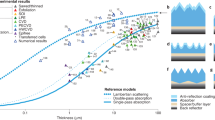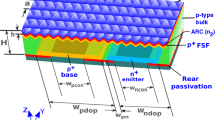Abstract
Conventional photovoltaic devices are currently made from relatively thick semiconductor layers, ~150 µm for silicon and 2–4 µm for Cu(In,Ga)(S,Se)2, CdTe or III–V direct bandgap semiconductors. Ultrathin solar cells using 10 times thinner absorbers could lead to considerable savings in material and processing time. Theoretical models suggest that light trapping can compensate for the reduced single-pass absorption, but optical and electrical losses have greatly limited the performances of previous attempts. Here, we propose a strategy based on multi-resonant absorption in planar active layers, and we report a 205-nm-thick GaAs solar cell with a certified efficiency of 19.9%. It uses a nanostructured silver back mirror fabricated by soft nanoimprint lithography. Broadband light trapping is achieved with multiple overlapping resonances induced by the grating and identified as Fabry–Perot and guided-mode resonances. A comprehensive optical and electrical analysis of the complete solar cell architecture provides a pathway for further improvements and shows that 25% efficiency is a realistic short-term target.
This is a preview of subscription content, access via your institution
Access options
Access Nature and 54 other Nature Portfolio journals
Get Nature+, our best-value online-access subscription
$29.99 / 30 days
cancel any time
Subscribe to this journal
Receive 12 digital issues and online access to articles
$119.00 per year
only $9.92 per issue
Buy this article
- Purchase on Springer Link
- Instant access to full article PDF
Prices may be subject to local taxes which are calculated during checkout




Similar content being viewed by others
Data availability
The data that support the plots within this paper and other findings of this study are available from the corresponding author upon reasonable request.
References
Yoshikawa, K. et al. Silicon heterojunction solar cell with interdigitated back contacts for a photoconversion efficiency over 26%. Nat. Energy 2, 17032 (2017).
Shockley, W. & Queisser, H. J. Detailed balance limit of efficiency of p–n junction solar cells. J. Appl. Phys. 32, 510–519 (1961).
Kayes, B. M. et al. 27.6% conversion efficiency, a new record for single-junction solar cells under 1 sun illumination. In Proc. 2011 37th IEEE Photovoltaic Specialists Conference (PVSC) 000004–000008 (IEEE, 2011).
Green, M. A. et al. Solar cell efficiency tables (Version 53). Prog. Photovolt. 27, 3–12 (2019).
Green, M. A. Lambertian light trapping in textured solar cells and light-emitting diodes: analytical solutions. Prog. Photovolt. 10, 235–241 (2002).
Yablonovitch, E. Statistical ray optics. J. Opt. Soc. Am. 72, 899–907 (1982).
Hirst, L. C. et al. Intrinsic radiation tolerance of ultra-thin GaAs solar cells. Appl. Phys. Lett. 109, 033908 (2016).
Brongersma, M. L., Cui, Y. & Fan, S. Light management for photovoltaics using high-index nanostructures. Nat. Mater. 13, 451–460 (2014).
Collin, S. Nanostructure arrays in free-space: optical properties and applications. Rep. Prog. Phys. 77, 126402 (2014).
Mokkapati, S. & Catchpole, K. R. Nanophotonic light trapping in solar cells. J. Appl. Phys. 112, 101101 (2012).
Depauw, V. et al. Sunlight-thin nanophotonic monocrystalline silicon solar cells. Nano Futures 1, 021001 (2017).
Branham, M. S. et al. 15.7% efficient 10-µm-thick crystalline silicon solar cells using periodic nanostructures. Adv. Mater. 27, 2182–2188 (2015).
Gaucher, A. et al. Ultrathin epitaxial silicon solar cells with inverted nanopyramid arrays for efficient light trapping. Nano Lett. 16, 5358–5364 (2016).
Wang, K. X., Yu, Z., Liu, V., Cui, Y. & Fan, S. Absorption enhancement in ultrathin crystalline silicon solar cells with antireflection and light-trapping nanocone gratings. Nano Lett. 12, 1616–1619 (2012).
Kapur, P. et al. A manufacturable, non-plated, non-Ag metallization based 20.44% efficient, 243 cm2 area, back contacted solar cell on 40 μm thick mono-crystalline silicon. In Proc. 28th European Photovoltaic Solar Energy Conference and Exhibition 2228–2231 (WIP Renewable Energies, 2013).
Cariou, R. et al. III–V-on-silicon solar cells reaching 33% photoconversion efficiency in two-terminal configuration. Nat. Energy 3, 326–333 (2018).
Goffard, J. et al. Light trapping in ultrathin CIGS solar cells with nanostructured back mirrors. IEEE J. Photovolt. 7, 1433–1441 (2017).
van Lare, C., Yin, G., Polman, A. & Schmid, M. Light coupling and trapping in ultrathin Cu(In,Ga)Se2 solar cells using dielectric scattering patterns. ACS Nano 9, 9603–9613 (2015).
Söderström, K., Haug, F.-J., Escarré, J., Cubero, O. & Ballif, C. Photocurrent increase in n–i–p thin film silicon solar cells by guided mode excitation via grating coupler. Appl. Phys. Lett. 96, 213508 (2010).
Zhu, J., Hsu, C.-M., Yu, Z., Fan, S. & Cui, Y. Nanodome solar cells with efficient light management and self-cleaning. Nano Lett. 10, 1979–1984 (2010).
Liu, W. et al. Surface plasmon enhanced GaAs thin film solar cells. Sol. Energy Mater. Sol. Cells 95, 693–698 (2011).
Nakayama, K., Tanabe, K. & Atwater, H. A. Plasmonic nanoparticle enhanced light absorption in GaAs solar cells. Appl. Phys. Lett. 93, 121904 (2008).
Massiot, I. et al. Metal nanogrid for broadband multiresonant light-harvesting in ultrathin GaAs layers. ACS Photon. 1, 878–884 (2014).
Atwater, H. A. & Polman, A. Plasmonics for improved photovoltaic devices. Nat. Mater. 9, 205–213 (2010).
Vandamme, N. et al. Ultrathin GaAs solar cells with a silver back mirror. IEEE J. Photovolt. 5, 565–570 (2015).
Miller, O. D., Yablonovitch, E. & Kurtz, S. R. Strong internal and external luminescence as solar cells approach the Shockley–Queisser limit. IEEE J. Photovolt. 2, 303–311 (2012).
Steiner, M. A. et al. Optical enhancement of the open-circuit voltage in high quality GaAs solar cells. J. Appl. Phys. 113, 123109 (2013).
Walker, A. W. et al. Impact of photon recycling on GaAs solar cell designs. IEEE J. Photovolt. 5, 1636–1645 (2015).
Yang, W. et al. Ultra-thin GaAs single-junction solar cells integrated with a reflective back scattering layer. J. Appl. Phys. 115, 203105 (2014).
Lee, S.-M. et al. High performance ultrathin GaAs solar cells enabled with heterogeneously integrated dielectric periodic nanostructures. ACS Nano 9, 10356–10365 (2015).
Hugonin, J. P. & Lalanne, P. Reticolo (IOTA/CNRS, 2005); https://www.lp2n.institutoptique.fr/Membres-Services/Responsables-d-equipe/LALANNE-Philippe
Lalanne, P. & Jurek, M. P. Computation of the near-field pattern with the coupled-wave method for transverse magnetic polarization. J. Mod. Opt. 45, 1357–1374 (1998).
Lalanne, P. & Morris, G. M. Highly improved convergence of the coupled-wave method for TM polarization. J. Opt. Soc. Am. A 13, 779–784 (1996).
Li, L. New formulation of the Fourier modal method for crossed surface-relief gratings. J. Opt. Soc. Am. A 14, 2758–2767 (1997).
Yeh, P. Optical Waves in Layered Media (Wiley, 1988).
Barugkin, C., Beck, F. J. & Catchpole, K. R. Diffuse reflectors for improving light management in solar cells: a review and outlook. J. Opt. 19, 014001 (2017).
Fu, S. M. et al. Approaching conversion limit with all-dielectric solar cell reflectors. Opt. Express 23, A106–A117 (2015).
Suckow, S. 2-3 diode fit. NanoHub (2014); https://nanohub.org/resources/14300
Ochoa, M., Algora, C., Espinet-González, P. & García, I. 3-D modeling of perimeter recombination in GaAs diodes and its influence on concentrator solar cells. Sol. Energy Mater. Sol. Cells 120, 48–58 (2014).
Sheldon, M. T., Eisler, C. N. & Atwater, H. A. GaAs passivation with trioctylphosphine sulfide for enhanced solar cell efficiency and durability. Adv. Energy Mater. 2, 339–344 (2012).
Espinet-González, P. et al. Analysis of perimeter recombination in the subcells of GaInP/GaAs/Ge triple-junction solar cells. Prog. Photovolt. Res. Appl. 23, 874–882 (2015).
Shen, T. C., Gao, G. B. & Morko, H. Recent developments in ohmic contacts for III–V compound semiconductors. J. Vac. Sci. Technol. B 10, 2113 (1992).
Sandhu, S., Yu, Z. & Fan, S. Detailed balance analysis of nanophotonic solar cells. Opt. Express 21, 1209–1217 (2013).
Xu, Y., Gong, T. & Munday, J. N. The generalized Shockley–Queisser limit for nanostructured solar cells. Sci. Rep. 5, 13536 (2015).
Jain, S. C., McGregor, J. M. & Roulston, D. J. Band-gap narrowing in novel III–V semiconductors. J. Appl. Phys. 68, 3747–3749 (1990).
Luo, C., Ni, X., Liu, L., Nomura, S. M. & Chen, Y. Degassing‐assisted patterning of cell culture surfaces. Biotechnol. Bioeng. 105, 854–859 (2010).
Dalstein, O. et al. Nanoimprinted, submicrometric, MOF-based 2D photonic structures: toward easy selective vapors sensing by a smartphone camera. Adv. Funct. Mater. 26, 81–90 (2016).
Wang, L., Wei, J. & Su, Z. Fabrication of surfaces with extremely high contact angle hysteresis from polyelectrolyte multilayer. Langmuir 27, 15299–15304 (2011).
Odom, T. W., Love, J. C., Wolfe, D. B., Paul, K. E. & Whitesides, G. M. Improved pattern transfer in soft lithography using composite stamps. Langmuir 18, 5314–5320 (2002).
Cattoni, A., Cambril, E., Decanini, D., Faini, G. & Haghiri-Gosnet, A. M. Soft UV-NIL at 20 nm scale using flexible bi-layer stamp casted on HSQ master mold. Microelectron. Eng. 87, 1015–1018 (2010).
Gao, L., Lemarchand, F. & Lequime, M. Exploitation of multiple incidences spectrometric measurements for thin film reverse engineering. Opt. Express 20, 15734–15751 (2012).
Palik, E. D. Handbook of Optical Constants of Solids (Academic Press, 1997).
Schubert M. & Woollam J. A. Isotropic dielectric functions of highly disordered AlxGa1−xInP (0 ≤ x ≤ 1) lattice matched to GaA. J. Appl. Phys. 86, 2025 (1999).
Sturge, M. D. Optical absorption of gallium arsenide between 0.6 and 2.75 eV. Phys. Rev. 127, 768–773 (1962).
Jiang, Y., Pillai, S. & Green, M. A. Realistic silver optical constants for plasmonics. Sci. Rep. 6, 30605 (2016).
Acknowledgements
The authors acknowledge discussions with J.-F. Guillemoles, electromagnetic simulation support from P. Lalanne, J.-P. Hugonin and C. Sauvan and financial support through French ANR project NANOCELL (grant no. ANR-15-CE05-0026) and the French Renatech network.
Author information
Authors and Affiliations
Contributions
H.-L.C. carried out most of the fabrication steps for the solar cell experiments at C2N and performed optical modelling and results analysis. A.W.W., O.H., D.L. and F.D. designed the optimized GaAs solar cell layer structure, D.L. wrote the recipe for epitaxy growth and G.S. evaluated the characterization results in the Fraunhofer ISE CalLab. H.-L.C., A.C., R.D.L., M.F., N.V., J.G., B.B., C.D. and N.B. developed and optimized the fabrication process. A.C. and M.F. specifically developed the nanoimprint process for TiO2 sol–gel films. N.V. contributed to the design and modelling of the devices. A.C. and S.C. developed the concept of ultrathin solar cells with a nanostructured back mirror and supervised the project. H.-L.C. and S.C. wrote the manuscript. All authors participated in the discussions and improvements of the manuscript.
Corresponding author
Ethics declarations
Competing interests
The authors declare no competing interests.
Additional information
Publisher’s note: Springer Nature remains neutral with regard to jurisdictional claims in published maps and institutional affiliations.
Supplementary information
Supplementary Information
Supplementary Figs. 1–18, Supplementary Notes 1–5, Supplementary Table 1, Supplementary refs. 1–8.
Rights and permissions
About this article
Cite this article
Chen, HL., Cattoni, A., De Lépinau, R. et al. A 19.9%-efficient ultrathin solar cell based on a 205-nm-thick GaAs absorber and a silver nanostructured back mirror. Nat Energy 4, 761–767 (2019). https://doi.org/10.1038/s41560-019-0434-y
Received:
Accepted:
Published:
Issue Date:
DOI: https://doi.org/10.1038/s41560-019-0434-y
This article is cited by
-
Powering AI at the edge: A robust, memristor-based binarized neural network with near-memory computing and miniaturized solar cell
Nature Communications (2024)
-
Resonant perovskite solar cells with extended band edge
Nature Communications (2023)
-
Recent Progress of Surface Plasmon–Enhanced Light Trapping in GaAs Thin-Film Solar Cells
Plasmonics (2023)
-
Cation disorder engineering yields AgBiS2 nanocrystals with enhanced optical absorption for efficient ultrathin solar cells
Nature Photonics (2022)
-
Light absorption enhancement in thin film GaAs solar cells using dielectric nanoparticles
Scientific Reports (2022)



